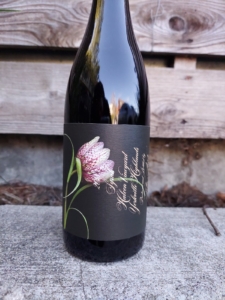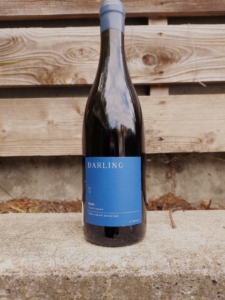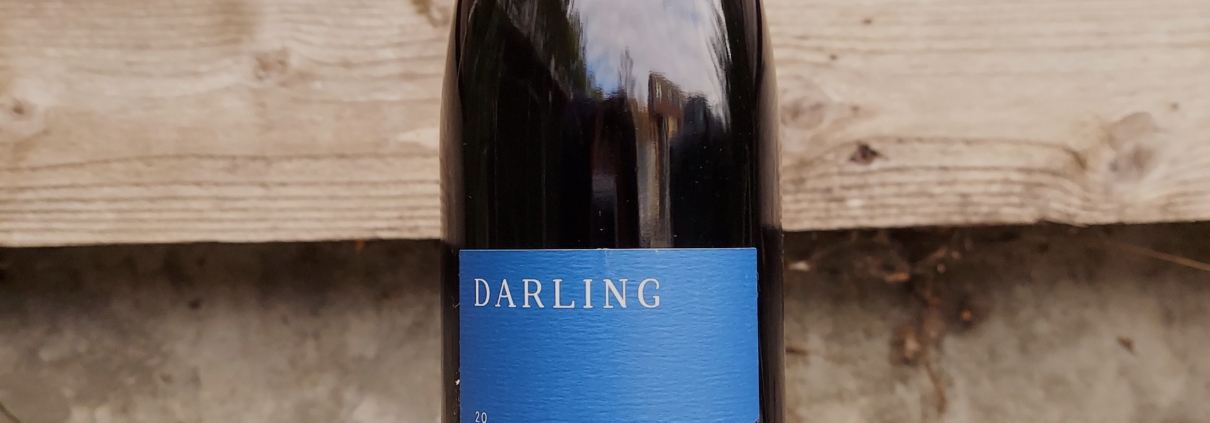The Beginning of Edmunds St. John
In the early 1980s, Steve Edmunds was a mild-mannered postman, delivering mail in the Bay Area. But his friends knew that something was wrong. Steve’s dissatisfaction with the U.S. Postal Service was evident, and his wife, psychologist Cornelia St. John, suggested that he find a new line of work to maintain his sanity. Then, in 1985, it happened – that crazy, rash moment of terrifying impulsiveness that we all fear, especially in a loved one –Steve started a winery.
Steve’s version of going postal wasn’t entirely unexpected; he had long been a home brewer and winemaker, and before his stint with the U.S.P.S., he worked in the retail end of the wine trade. Over the years, a chorus of his friends, led by Cornelia, had encouraged him to make wine commercially. So, with Cornelia’s blessing and support, Steve founded Edmunds St. John winery.
Steve was one of the first California winemakers to focus on Rhône grape varietals like Syrah and Mourvèdre. He was one of the earliest and remains one of the most vocal proponents of terroir in California–of making wines that express as vividly as possible the place where the grapes are grown. In March and April, the crew at Paul Marcus Wines had the pleasure of getting together with Steve over meals to discuss his winemaking and enjoy many of his currently released wines.
Wine Made For Food
The fun began when Paul Courtright and I joined Steve for lunch at Grasshopper on College Avenue. When we asked Steve how he did things differently than many other California winemakers, he responded: “It’s about balance. The wine shouldn’t push the food off the table. Wine should invite you to eat – and to drink more!”
And so we did. Steve popped the corks on his 2000 Pinc Froid (a rosé made from Nebbiolo grapes) and 2001 Los Robles Viejos White (a blend of Rhône white varietals – Roussanne, Viogner, and Marsanne – all grown in the Rozet Vineyard near Paso Robles) as our waiter delivered fried calamari and peanut chicken salad.
Steve explained that the first thing he did when he decided to make wine commercially was to taste a lot of wine to find out what exactly he wanted to make. During this oenological odyssey, he found that the wines he kept coming back to were from southeastern France and northern Italy. At the same time, he read some articles about carbonic maceration, a traditional southern French winemaking technique that can yield wines with more distinctive aromas and delicate flavors. He also read an article by Robert Mayberry, author of the book Wines of the Rhône Valley: A Guide to Origins. Mayberry suggested that someone find some old-vine Mourvèdre, Carignan, and Grenache in California and make a Côtes-du-Rhône style wine using carbonic maceration and neutral (i.e., not oaky) aging vessels.
An “Aha” Moment
These enticing but discrete hints came together for Steve when he tasted a 1983 Qupé Syrah during a meal at Chez Panisse. (In those days, California Syrah was about as common as vineyard-designated California Cabernet.) Steve describes this as his “aha” moment: “I realized that someone could make good California wine from Rhône varietals. There were too many signs from the universe that I should do this.”
As our 12-spice pork ribs arrived, Steve paused to open his 2001 California Syrah and then continued his saga. Syrah was to play a large part in Steve’s future, and he, along with others like Bob Lindquist of Qupé and John Alban of Alban Vineyards, helped put Syrah on the map in California. But Steve was at least as captivated by Mourvèdre, the primary varietal in Bandol rouge and an important supporting player in Châteauneuf-du-Pape and other southern Rhône reds. The trick back in the mid 1980s was finding any Mourvèdre (or Mataro, as it was known to California grape growers).
Choosing a Vineyard
After much fruitless searching, in 1986 Steve discovered the Brandlin Ranch on Mt. Veeder above Napa Valley. Richard and Chester Brandlin were growing old-fashioned grape varietals using old-fashioned techniques that respected the soil and the plants. Steve snapped up the small amount of Mourvèdre that they were growing and used the grapes to make the best wine of his second vintage, in 1986. As Steve proudly points out, François Peyraud of the famous Bandol producer Domaine Tempier said of this wine when he tasted it, “la terre parle” (“the earth speaks”).
Since then, Steve has reprised this combination of serendipitous grape sourcing and skillful, minimalist winemaking many times. We asked him how he thinks about the process of making a great bottle of wine.
Steps To Producing Great Wine
First is the place – the fruit source. Steve described his job as “finding places that create distinctive grapes”. He’s concerned about the appropriateness of the grape varietal to the site, of course, but he’s looking for more than mere appropriateness; he wants sites that demonstrate a particular, unique character. Steve has managed repeatedly to unearth great, distinctive vineyards that are farmed by people who really know and care about their land.
Second is picking fruit at optimum ripeness rather than hyper-ripeness. As Steve said of winegrowing in the balmy California climate, “you’ve got power; you don’t need to do anything to generate power”. In fact, you need to ensure that you don’t let this natural advantage turn into a freakish caricature. Steve works with his growers throughout the season, tastes the grapes every week, and then leads the harvesting when he determines that the grapes have fully developed their flavors without losing their fresh acidity.
Letting Nature Take The Reigns
And finally, Steve says his job in the winery is to “get out of the way”. In other words, he ferments the grapes and lets them turn themselves into wine with as little additional manipulation as possible. His youngest barrels are 13 years old, so there’s no oak obscuring the distinctiveness of his grapes. He eschews high-tech gear and instead uses old-world winemaking techniques that preserve and accentuate terroir.
The most exciting manifestation of all of this theory at the moment is in Steve’s new Los Robles Viejos wines from the Rozet vineyard west of Paso Robles, in San Luis Obispo County. In addition to the white wine mentioned above, there’s Los Robles Viejos Red – a blend of Mourvèdre, Syrah, Grenache, and Counoise from the Rozet vineyard. Some of the grapes also find their way into his ever-popular Rocks and Gravel – Grenache, Mourvèdre, and Syrah blended from vineyards in Mendocino, El Dorado, and San Luis Obispo Counties. Steve is particularly enthusiastic about the Mourvèdre from Rozet: “We’ve harvested grapes for three years now, and each year the Mourvèdre is the best. It makes a wine that has a distinct identity.”
The Châteauneuf challenge
Although Steve strives to make wines that speak of where they’re grown – which is to say, specific vineyards in California – his models are the wines of the northern and southern Rhône in France. While California wines have plenty of power and luscious fruitiness, many of them lack the specificity, subtlety, complexity, and food-friendliness of their European models. In a friendly challenge to the two best appellations in the Southern Rhône, Steve put his Rocks and Gravel and Los Robles Viejos Red up against several excellent wines from Gigondas and Châteauneuf-du-Pape. Most of the staff of Paul Marcus Wines got together with Steve for a tasting and dinner at my house in Oakland. We were joined by Keven Clancy, the representative from Estate Wines Ltd. who sells us Edmunds St. John wines, and Patrick Comiskey, Senior Editor of Wine and Spirits magazine and columnist for the San Francisco Chronicle’s wine section.
All of us knew that we were tasting 2000 vintage Edmunds St. John, Gigondas, and Châteauneuf-du-Pape wines, but we didn’t know the specific identities of the wines, and we carried out the tasting blind (that is, the bottles were covered up until after we’d tasted and discussed them). The “Gigondas flight” of wines comprised the Edmunds St. John Rocks and Gravel, Domaine de Font-Sane Gigondas, and Château du Trignon Gigondas. The “Châteauneuf flight” contained four wines: Edmunds St. John Los Robles Viejos Red and Châteauneuf-du-Pape from Clos des Papes, Vieux Télégraphe, and Domaine Pierre Usseglio & Fils.
Testing The Wines
In both flights, Steve’s wines showed themselves as worthy peers of their French brethren. Neither of his wines stuck out as being obviously Californian – our guesses about which wine in each flight came from California frequently were wrong. Nor did Steve’s wines seem simpler or less food-friendly than the others. (After the analytical phase of the tasting, we tucked into a big pile of grilled meats and sausages.)
As I look back over some of our notes from that evening, my central impression is that all of the wines sat comfortably at the table as peers. We quickly moved beyond the “spot the California wine” game to more interesting questions of how each wine distinguished itself in terms of floral, animal, spicy, sappy, tannic, and acidic qualities. All of these were wines worth drinking and cellaring, wines that invited us to eat (and to drink more!), wines that made our evening together a finer one.
But wait, there’s more!
Steve is a man of many talents. Besides making great wine, he’s an accomplished singer-songwriter and an inspired writer. To verify the latter claim, visit edmundsstjohn.com and check out any of his newsletters. Then subscribe to the organolepticians, which grants you the privilege of receiving his future newsletters via e-mail. You’ll hear about, among other useful things, the annual Edmunds St. John Post-Harvest, Pre-Holiday shindig in December, which is always fun and tasty. The Edmunds St. John Web site also describes Steve’s CD Lonesome on the Ground, which we have available for sale in the store.
Note: Steve is also the the object of an article by Patrick Comiskey that was published in the San Francisco Chronicle’s wine section on Thursday June 12, 2003.
PMW California Favorites
2000 Pinc Froid ($10.99)
This wine is almost too much fun. It’s rosé from Nebbiolo grapes, in the style of a northern Italian rosato from Piemonte. The wine is full-flavored, minerally, dry, and just a touch smoky. It’s a great aperitif and sit-out-on-the-deck-with-friends wine. It adds an increment of pleasure to any barbecue. And it goes perfectly with 1970s album-length rock songs.
2001 California Syrah ($18)
Here’s one of the great bargains in California wine – a sophisticated but friendly Syrah for under twenty bucks. It’s medium-bodied, supple, clean, and just fruity enough without being excessively grapey. Like all of Steve’s wines, the California Syrah plays well with a wide range of foods. We’ve enjoyed it with grilled meats and even not-too-sweet Asian dishes.
2000 Los Robles Viejos White and Red ($25 each)
If you want to know what terroir is about in California, then you’ll want to drink and cellar these Southern Rhône style wines from the Rozet Vineyard in San Luis Obispo County. And even if you don’t care about terroir, you’ll want to drink these wines because they’re just so damned delicious! Rich Roussane sings the main melody in the white wine, while meaty Mourvèdre forms the backbone of the red. It would be hard to find a better match than these wines for southern French cuisine and Mediterranean-inspired California dishes.
Sky Vineyards
1999 Zinfandel ($25)
Sky makes our favorite Zinfandels year in and year out. This is artisanal wine at its best. Winegrower Lore Olds and his daughter Maya tend their vines just below the crest of Mt. Veeder and make their wine by hand. Sky Zinfandel has plenty of lip-smackingly luscious fruit, but unlike a lot of other Zinfandels, this one is sophisticated, balanced, and a great complement to food. It also ages magnificently – we recently had the pleasure of drinking the 1989 and 1990 vintages up at Sky. So get a few bottles for now and a few more to stash in your basement or closet. You won’t regret it now or later.
Babcock
Brian Babcock’s 2001 Santa Barbara County Chardonnay ($16.50) is one unbelievable wine for the money. It’s one of our biggest sellers – not too oaky, but with plenty of richness and length on the palate. This is a “go to” wine, meaning that it’s a wine for anyone just starting out and a screaming deal for everyone.
Palmina
We don’t normally get excited about Italian-style wines made in California – the Italian originals usually are better wines and better values. But we are excited about the wines that we just started carrying from Palmina in Santa Barbara County. Steve Clifton, of Brewer-Clifton Chardonnay and Pinot Noir fame, is the owner and winemaker.
The 2002 Bianca ($21)
This is a blend of Traminer, Sauvignon Blanc, Malvasia, Tocai, and Pinot Grigio. Here’s Chad’s inimitable description: “Sumptuous honeyed notes revolving in perfect circles around further perfect circles of melon and fig. A spicy gasket of viscous cinnamon and nectarine all supported by vibrant acids and perfect balance! Wow. This is an intellectual’s entry back into the wonderful world of stuff. Wonderful stuff.”
The 2000 Nebbiolo ($32)
Coming from the Stolpman vineyard in the Santa Ynez Valley, this wine leans towards the floral side of Nebbiolo – violets, rose petals, cherries, and a little cedar – and displays that classic Nebbiolo combination of power and elegance. Serve it with braised or roasted meats or simply with a nice piece of aged Parmigiano Reggiano.
 Jolie-Laide has established itself as one of California’s premier (tiny) wineries. Their wines are made in small quantities, and the demand for them is strong, so we don’t get much to sell. Their 2018 Halcón Vineyard syrah, from 2600 feet up in the Yorkville Highlands AVA in Mendocino, is a beauty. At 12.5 percent alcohol, it offers texture, flavor, and weight that would delight even a crusty Frenchman.
Jolie-Laide has established itself as one of California’s premier (tiny) wineries. Their wines are made in small quantities, and the demand for them is strong, so we don’t get much to sell. Their 2018 Halcón Vineyard syrah, from 2600 feet up in the Yorkville Highlands AVA in Mendocino, is a beauty. At 12.5 percent alcohol, it offers texture, flavor, and weight that would delight even a crusty Frenchman. Jolie-Laide being excellent isn’t shocking; they’ve now got a 10-year track record. Newcomer Darling Wines, however, is a surprise. The 2019 Flocchini syrah, made in the southern portion of the Petaluma Gap AVA, not far from San Pablo Bay and in the path of constant winds, is a baffling wine. It’s one thing to get perfumed voluptuous fruit (that’s easy in this state); it’s another to have your wine come in at 11.9 percent alcohol, with all the virtues that brings. (That lightness encourages another glass.) It’s really a treat to get both in the same wine.
Jolie-Laide being excellent isn’t shocking; they’ve now got a 10-year track record. Newcomer Darling Wines, however, is a surprise. The 2019 Flocchini syrah, made in the southern portion of the Petaluma Gap AVA, not far from San Pablo Bay and in the path of constant winds, is a baffling wine. It’s one thing to get perfumed voluptuous fruit (that’s easy in this state); it’s another to have your wine come in at 11.9 percent alcohol, with all the virtues that brings. (That lightness encourages another glass.) It’s really a treat to get both in the same wine.
